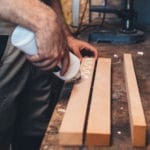Epoxy is a flexible substance utilized in various industries, including construction, automotive, electronics, aerospace, and even art. It’s also an excellent bonding agent that can be used on almost any surface.
However, epoxy has one difficulty: it takes a long time to dry. It might take weeks or months for an epoxy project to cure completely.
This can be frustrating if you’re eager to use epoxy or items coated with space. Fortunately, there are a few things that you can do to speed up the curing process. In most cases, you’ll be able to use the epoxy-coated item within 24 hours of application safely.
If you cannot use the item immediately, cover it with a dust sheet or other protective covering to keep it from becoming dirty or scratched.
Also, avoid stepping on the epoxy-coated area until it’s fully dry. By following these simple steps, you’ll be able to enjoy your new epoxy project in no time.
Consider waiting 7 days before relocating furniture back on a floor or putting any sort of appliances, such as a blender or microwave, on top of your counters. Several factors influence the cure time and how long it takes for the process to fully mature, and they all play a role in the removal process.
Many things like slab temperature, ambient temperature, humidity levels, etc. But just to be on the safer end, epoxy will be hard within about 24 hours, and it’ll be rock hard and have almost a complete full cure time after about 7 days.
How Can I Speed Up the Epoxy Curing Process?
Create a humid atmosphere, a warm environment, or, if possible, a free-flowing ventilating environment to expedite the curing time of epoxy products. Even so, certain epoxy materials cure incredibly fast.
The only disadvantage is that they can be quite costly. To apply them correctly, they may need significant experience and expertise.
If the concrete floor is acceptable, you may be satisfied with the results. However, if you do not inspect your floors once they have hardened, you might encounter severe problems. Let’s say that you had a poor-quality concrete floor poured. It was hot on the pouring day, so the concrete added extra water to the mix.
Related: How Long Does Wood Glue Take to Dry?
The next day, the floor cooled down and contracted. Result: cracks!
If you have used a poor-quality epoxy resin or hardener, or if the temperature was too low during the application, the surface may not have cured properly. As a result, it will be very soft and gummy to the touch. It is not cured if you can scratch the surface with your fingernail!
In this case, you will need to remove the epoxy and start again.
How to Remove Epoxy Floor Coatings?
Removing an epoxy coating from a concrete surface can be difficult, time-consuming, and expensive. It is important to remember that not all epoxy coatings are created equal. There are many different types and formulations of epoxy, and each one will require a different removal process.
The first step in removing an epoxy coating is identifying the type of epoxy used. The most common types of epoxy are one-part and two-part systems. One-part epoxies are typically easier to remove than two-part systems.
Once you have determined the type of epoxy, you will need to select the appropriate removal method. The most common methods for removing epoxy coatings are mechanical abrasion, chemical stripping, and thermal decomposition.
Each of these methods has its advantages and disadvantages. Mechanical abrasion is the most common method for removing epoxy coatings. It is fast, efficient, and relatively inexpensive. The downside of mechanical abrasion is that it can damage the concrete surface and create a lot of dust.
Chemical stripping is another popular method for removing epoxy coatings. Chemical strippers are typically more expensive than abrasion methods but are much less likely to damage the concrete. The main disadvantage of chemical stripping is that it is a slow process.
Thermal decomposition is the third most common method for removing epoxy coatings. Thermal decomposition uses heat to break down epoxy into its parts. The advantage of thermal decomposition is that it is fast and efficient. The downside is that it can damage the concrete surface.
In most cases, the best way to remove an epoxy coating is to use a combination of methods. This approach allows you to take advantage of the strengths of each method while avoiding weaknesses.
How to Apply Epoxy to Floors During Cold Temperatures?
When you apply epoxy floors, the temperature will affect the application. Applying it in the winter and summer can give very different results. And you must understand the differences and be well prepared in advance.
Epoxy flooring products should ideally be applied between 50°F – 86°F (10°C – 30°C). Ideal conditions would be 77°F (25°C). It’s not too hot or cold. Those are the ideal circumstances. However, we never have ideal circumstances because anyone who works in epoxy flooring will tell you. It’s always hot, it’s always cold, and it’s always raining.
So what do you do if the temperature is not ideal?
If the temperature is below 10°C or above 30°C, you should wait until the temperature is within the ideal range to apply the epoxy flooring product. If you can’t wait, then there are some things you can do to help improve the results.
You can warm up the substrate in cold weather with a heat gun or a hairdryer. This will help the epoxy to cure properly and avoid cracks. You can cool down the substrate with ice or water in hot weather. This will help to prevent the epoxy from curing too quickly and forming cracks.
Will Winter Temperature Change the Curing Time?
Yes, weather conditions can impact the viscoelastic properties of epoxy flooring. Therefore they may play a part in the installation. The ideal temperature range for utilizing epoxy is typically between 55°F and 90°F. Some epoxies and polymers, however, are designed to be used at temperatures as low as below zero.
Before a concrete slab may be put in place, it must be kept at a minimum of 40°F.
During the curing process, you should ensure that the slab is maintained at this temperature. If you reside in a chilly environment, you might have to wait days for the slab to reach an acceptable temperature.
Humidity can also impact how long your floor takes to cure. It is crucial to wait until humidity levels drop below 85% before laying down your new floor. This will help prevent a thin layer of moisture from accumulating on the epoxy and drawing away from its adhesion to the surface, particularly if you’re using a resin-based product.
What to Look For When Applying Epoxy in Cold Temperature?
Pot Life
When it comes to epoxy, the first thing we should look for is whether or not the pot life or time it takes for the solution to react is longer when you’re applying and utilizing cold temperatures.
This indicates you’ll have more time to work with the product.
In extremely cold weather, a standard product will take 30 minutes to cure, and it warms up and flashes, allowing for extra time to work with it. This may be beneficial since you have more time to work with a product in freezing temperatures.
However, the temperature is really low will impact record windows and project completion times.
Higher Humidity
The second thing to remember is that humidity is typically higher in the winter. This isn’t a hard and fast rule, but most of the time, you have high humidity in the winter, which causes condensation problems.
When applying epoxy, you must work at least 39.2°F (4°C) above the dew point.
Leveling
The product is too thick when it’s cold, and because of its high viscosity, the flow isn’t as good as it’s cold. As a result of the chilly temperature, the epoxy doesn’t settle correctly, doesn’t level properly, and leaves marks on your nails.
If the material can not self-level, you may spend more time on the project.
How to Fix Ripples in Epoxy?
Heat the room in advance.
Make it warm if you’re at a location with air conditioning or heating. Warm the space so that we may work comfortably. Remember, do not use propane. Propane fumes can corrode epoxy and leave odd-looking blotches and discoloration on them.
As a result, don’t utilize propane. Electrical heaters are the safest way to heat the room.
Keep everything at normal room temperature.
Even if it’s extremely chilly outside, you may keep the products stored in a warm place. So when you use them, the actual temperature of the goods isn’t that chilly, which will aid with curing and leveling.
Don’t keep them in a cold environment where they’ll be freezing overnight or even within a few degrees of freezing.
While it might be tempting to work in the cold because of the excitement, you should avoid doing so since it is unsafe. You should aim for a temperature of at least 50°F (10°C), although this is preferable not to work below 60°F (15°C).
Solvent addition
Another thing you can do to enhance the mixture has added some solvent. You’ll use a solvent appropriate for your product, such as epoxy for the xylem. And what you may do here is improve the flow of the material by adding solvent. However, it will only exacerbate the curing process, so you know. But at least you can work with it and get it to level out.
How to Apply Epoxy to Floor During Hot Temperature?
Working in a warm environment is always preferable to working in cold temperatures.
Curing time
When temperatures are high, the curing time is reduced drastically. As a result, floors cure faster in warm environments, allowing you to finish tasks in less time.
Yes, you can finish a project and give it to your client on the one hand. However, it also implies that you must be cautious while working with the product.
If you’re used to working with a product that takes 40 minutes to cure, it may start flashing at 25 minutes or 20 minutes, or even 15 minutes, reducing the time you have to work with it.
You also need well-organized workers who know what’s going on, as well as those who understand they must work quickly. This is crucial. You should prepare them in advance if employees are not used to working in high temperatures.
When the job begins during the application, don’t expect anyone to figure it out independently.
Leveling
Hot weather aids in the product’s flow and leveling. When it’s cold, you get strange trial marks on your product. Even though it appears to be level, it doesn’t look very nice.
So, when you’re working on a warm substrate and the temperature is pleasant and cozy, you may achieve fantastic finishes during the summer.
Safety
The chemicals can induce nausea and dizziness when you breathe in the odors, whether just some compounds in the epoxy chemicals or whatever solvent he used to clean your equipment. These things result in fumes and scents.
When it’s cold, the noxious fumes are less of a problem. When it’s hot, you’re sweating, feeling drowsy due to the heat, and smelling something extra can sometimes be overwhelming. So bear this in mind when working with solvents.
You don’t want it to be too hot. Working with stinky stuff during the summer can be stressful, so take care. So make sure you use all of your safety precautions.
In the summer, employees are less inclined to wear masks due to their perspiration and stuffiness. As a result, they want to take off their masks. They breathe in all these solvents and other chemicals when they remove their masks.
So you should think about how hot weather might jeopardize safety.
How Should I Keep the Floors Clean?
If you can accomplish something on your own, go for it. But if you require assistance, seek recommendations from friends and family. You may discover that this is the most effective option for new flooring.
Acid cleaners, on the other hand, are generally detrimental to your flooring. They may rather harm your floors than polish them.
Conclusion
After applying the resin and hardener evenly on the marble, allow it to dry for 48 hours in a warm place or per the local weather conditions. This is because the solution goes down to the bottom, completely dried.
When it’s hot outside, it’s important to talk to your workers and remind them of the dangers of working in the heat. You also need to be careful not to sweat too much because if the sweat drips on the floor or any coating, it can cause discoloration or moisture problems.





